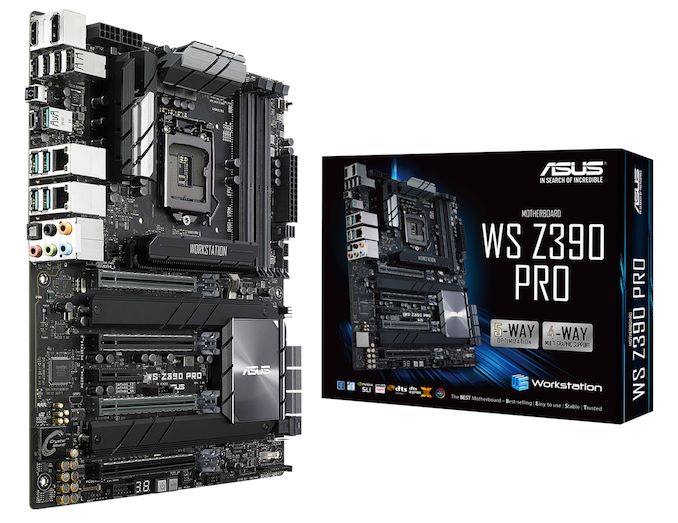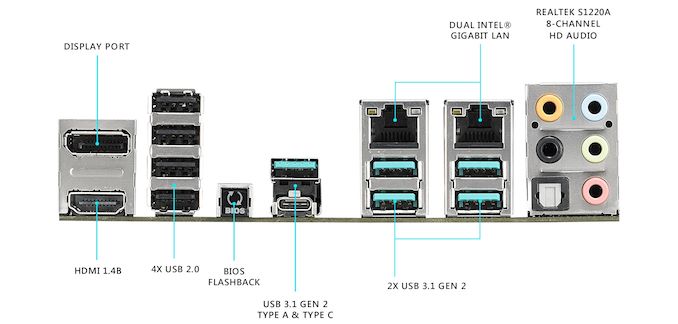Intel Z390 Motherboard Overview: 50+ Motherboards Analyzed
by Ian Cutress & Gavin Bonshor on October 8, 2018 10:53 AM EST- Posted in
- Motherboards
- Intel
- MSI
- Gigabyte
- ASRock
- EVGA
- Asus
- NZXT
- Supermicro
- Z390
ASUS WS Z390 Pro
Outside of the gaming-centric offerings on the new Z390 chipset, the ASUS WS Z390 Pro is one of the most comprehensive with a massive set of specifications and feature-rich list that makes this a very attractive high-end option. Stylistically the board has a subtle black and silver theme throughout with a glossy silver chipset heatsink. The WS stands for workstation and is designed specifically for professional users looking to build a high powered multi-core system with one of the higher end Intel Core i9- 9900K processors. The biggest feature of the WS Z390 Pro is in its ability to run up to four-way SLI thanks to four Safe Slot protected full-length PCIe 3.0 slots. The top two operate with a bandwidth of x16/x16 with two cards installed, x16/x8/x8 with three cards and x8/x8/x8/x8 with four graphics cards. Although the WS Z390 Pro has no PCIe 3.0 x1 slots to speak of, it has a single PCIe 3.0 x4 slot located between the full-length slots.
The storage options of the WS Z390 Pro includes three M.2 PCIe 3.0 slots with two of them having support for SATA drives too; also present is six SATA ports with support for RAID 0, 1, 5 and 10 arrays. The WS Z390 Pro also features two U.2 ports. The board is equipped with four RAM slots with support for DDR4-4266 and a total capacity of up to 64 GB. A total of six 4-pin PWM enabled headers are located on the board and ASUS has included two 8-pin 12 V ATX CPU power inputs for overclockers to make use of.
The WS Z390 Pro focuses less on gaming orientated features and more on professional elements with a Realtek S1200A HD audio codec powered the five 3.5 mm audio jacks and S/PDIF optical output. The rear panel also features dual Intel Gigabit LAN with an Intel I21LM and Intel I210AT Gigabit NIC. A total of ten USB ports are located on the rear panel which is split into five USB 3.1 Gen2 Type-A, one USB 3.1 Gen2 Type-C and four USB 2.0 ports. At the far left-hand side is a DisplayPort and HDMI 2.0b pair of video outputs and the WS Z390 Pro has a handily located BIOS Flashback button on the rear panel too.
As expected the WS Z390 Pro will most certainly be one of the most expensive Z390 ASUS boards at launch, with the pricing currently unknown and looks set to offer prosumers a four-way SLI capable desktop offering from one of the biggest brands in the industry. The USB 3.1 Gen2 integration in the Z390 chipset has been made to great use and the WS Z390 Pro offers the one of the most comprehensively implemented feature-sets on the entirety of the chipset. It's slightly disappointing that there's no 5 G or 10 G Aquantia LAN to be seen and this would have been a much-welcomed feature for workstation users to sink their teeth into.












79 Comments
View All Comments
Valantar - Wednesday, October 10, 2018 - link
That would be pretty shocking, yeah, but the sheer size of that lump of metal still has me a bit worried. Guess that's what you get when you try to squeeze power delivery for a CPU that (likely) pulls >300W when overclocked into an ITX board (and refuse to use riser boards like before, for some reason).FXi - Monday, October 8, 2018 - link
The power feed also changed with z390 I believe at least in the Asus models it did. The power feed of the 370 was "enough" to drive the newer 9700/9900 but there is a difference there that may impact enthusiasts. I don't think it enough to warrant an upgrade but something to consider.Also people should remember that while it is still a bit of a ways off, wifi is going to change to Wifi6 or 802.11ax starting now and probably seeing much of the changeover during 2019/2020 depending on adoption choices. And there is also pci-e 4.0 to consider next year probably that should be thought about before people do "marginal" upgrades from 370 era chipsets.
FXi - Monday, October 8, 2018 - link
Silly thing posted in edit window. Sorry power delivery and other points covered by you. Would have edited if I could have found that optionDanNeely - Monday, October 8, 2018 - link
Other things to look forward to in the next few generations are: Less-hacky USB3.1 implementations (eg this articles speculation that a 10g port will need to eat 2 HSIO lanes instead of 1, and still needing an extra chip to support USB-C). Spectre/Meltdown fixes in hardware. A reduced DMI bottleneck between the CPU and chipset (either just from upgrading the link to PCIe4/5, moving some of the peripheral IO onto the CPU, or both.Valantar - Wednesday, October 10, 2018 - link
Considering that the maximum theoretical bandwidth of PCIe 3.0 x1 is 984.6MB/s, you _need_ two PCIe lanes (and thus two HSIO lanes) for a USB 3.1G2 (1.25GB/s) controller unless you want to significantly bottleneck it. That's not "hacky", that's reality, even if this leaves a lot of bandwidth "on the table" if this only powers a single port (which it rarely does, though, and given that a full load on two ports at one time is unlikely, running two 1.25GB/s ports off two .99GB/s lanes is a good solution).Moving DMI to PCIe 4.0 will be good, though, particularly for multiple NVMe SSDs and >GbE networking.
DanNeely - Wednesday, October 10, 2018 - link
Splitting the traffic over 2 HSIO lanes is a hack because it'd require something to split/combine the traffic between the chipset and usbport. That in turn has me wondering if the speculation about the implementation being done that way is correct, or if the Z390 has 6 HSIO lanes that can run 10Gbps instead of the 8 that the rest top out at for PCIe3repoman27 - Thursday, October 18, 2018 - link
The implementation is absolutely not done that way. HSIO lanes are simply differential signaling pairs connected to a PCIe switch or various controllers via a mux. The PCH has a 6-port USB 3.1 Gen 2 xHCI, which can only feed 6 HSIO muxes. The back end of that xHCI is connected to an on-die PCIe switch which in turn is connected to the DMI interface. That DMI 3.0 x4 interface is already massively oversubscribed, but it is at least equivalent to a PCIe 3.0 x4 link, which is the most bandwidth that can be allotted to a single PCH connected device.Srikzquest - Monday, October 8, 2018 - link
HDMI 2.0 is available in Asus and Gigabyte's ITX boards as well.gavbon - Tuesday, October 9, 2018 - link
Thank you Srikzquest; updated the tables, obviously missed this yesterday :) - Thanks againHickorySwitch - Monday, October 8, 2018 - link
Correction:https://www.asus.com/us/Commercial-Servers-Worksta...
It says under "Specifications" that the board sports HDMI 2.0[b?]